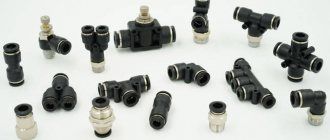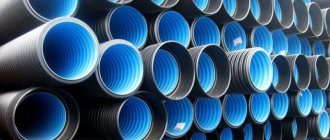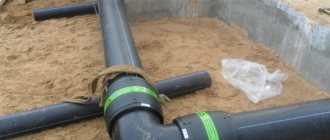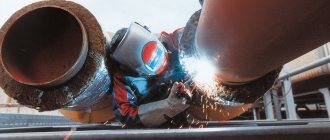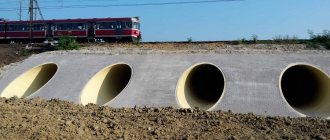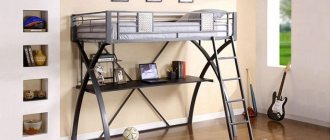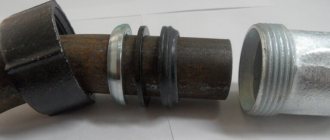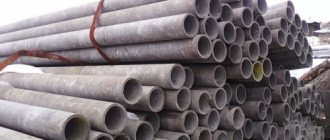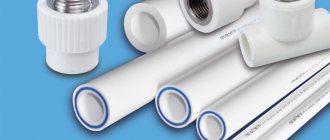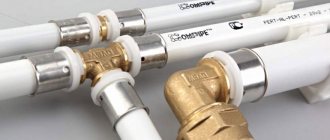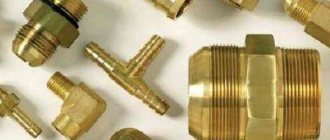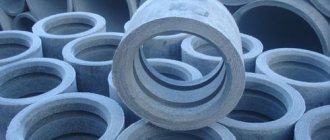What is HDPE pipe
These pipes are made from a polymer called low-density polyethylene. The material is distinguished by such qualities as high strength, lightness, chemical safety (does not enter into any chemical reactions), and the absence of harmful impurities in the material, which is the key to its safety for use. The polymer does not expand when exposed to heat; HDPE pipes have a high coefficient of elasticity (when water in the pipe freezes, the pipe does not burst). Due to the smoothness of the inner walls, plaque does not deposit inside the pipe.
The main advantage of HDPE pipes over others is the ability to install them yourself, without renting special equipment or calling the appropriate specialists. But, despite the wide range of advantages, there are also two significant disadvantages when using HDPE pipes: they cannot be used for installing a hot water supply system. The temperature inside the pipe should not exceed 40°C. And from the direct action of ultraviolet radiation, the polymer quickly loses strength.
Connection with couplings
The couplings are made of polyethylene and are widely used in pipeline assembly. In addition to the fact that with their help you can quickly and without unnecessary hassle assemble pipes into a single whole, they also have a number of advantages:
- The result is a reliable fastening with a long service life; Withstands temperature changes and mechanical stress; Can be used for any type of pipeline. Affordable price.
The pipeline is installed using different types of couplings:
- Compression - can have different threads: external or internal. Compression couplings can be used even when assembling gas systems and water supply systems. Connecting couplings - connect elements of the same diameter. Reducing couplings - are indispensable for connecting elements of pipes of different diameters.
Docking of HDPE fittings
Basically, special fittings are used to connect HDPE pipes. The easiest way to connect these pipes yourself is to install a compression fitting. It can handle water pressure up to 10 atmospheres. The compression type fitting is equipped with the following components:
- fitting body;
- clamping nut;
- collet;
- retaining ring;
- rubber gasket.
Before connecting pipes, their ends should be prepared for installation. Pipe cuts must be strictly perpendicular and free from roughness or burrs. A mark is made along the outer edge of the pipe (in order not to damage the rubber gasket).
Installation of the fitting is carried out as follows: put a clamping nut on the finished pipe in the following order, then a collet and a stopper ring. We place a rubber gasket in the housing. We connect the body to the pipe with pre-assembled parts, and tighten it firmly, with force.
Installation of connections for control and shut-off valves has its own characteristics. One side of the fitting has a special flange, the other has an outlet system for the intended type of connection. The connection of such a fitting is carried out using nuts, bolts and special gaskets.
Advice from experienced specialists
The ellipticity of the material can negatively affect the tightness. In this case, the seams will be of poor quality. If the contact is made by welding, then it is important to monitor the immobility of the pipes until the materials completely harden.
Equipment for welding seam Source i.ytimg.com
The ends of the products to be joined must be prepared in advance. This means removing dirt and dust. Additionally, you need to treat the surface with a degreaser.
If fittings with clamping nuts are used, it is important to tighten them to the limit, but not significantly. Excessive force may cause the element to burst. And the collet in this case is capable of crushing the end part of the pipe.
Connecting HDPE to polypropylene pipe
Sometimes situations arise when, during the manufacturing process of a pipeline, you have to deal with different pipes made of different materials. Most often, such situations occur during the installation of irrigation systems.
Let's consider the situation using the example of joining a polypropylene (cut) pipe with a HDPE pipe. To connect polypropylene pipes with other types of pipes, specialized fittings have been created with one-sided threads. The part of such a fitting that is without thread is welded to a PP pipe, and the opposite side (where the thread is) is connected to a pipe of the same diameter (made of HDPE).
The thread of the fitting system for joining different types of pipes can be found both externally and internally. It is also possible to install 2 types of these pipes using a part such as a combined coupling. In this situation, a collet connection with thread is attached to the HDPE pipe, and a combined coupling is installed on the propylene pipe. For better sealing, fum tape or a similar sealant is screwed onto the thread before tightening. Next, the structure is screwed in with force.
The simplest way is to connect two types of different pipes (HDPE and polypropylene) using a flange. To improve the sealing properties, a rubber gasket is inserted between the flanges. The structure is tightened with bolts. When preparing pipes from different materials for installation, their dimensional parameters and technological properties should be taken into account; the surfaces to be connected must be cleaned and prepared.
Installation features
The connection of individual sections of a conducting hydraulic main can occur in two different ways - detachable and permanent . How to connect HDPE pipes without welding - with fittings? The choice of method is determined by the purpose of this structure.
A permanent connection is most often used if liquid will be supplied there under pressure.
The end-to-end fastening of pipeline fragments is carried out using mechanical or electro-hydraulic welding. Detachable water pipelines are created in the case of installation of gravity systems. For example, this could be a home sewer system, where water will definitely not flow under pressure. Devices from elements of small cross-section, from 50 mm and below, and conductive lines are also assembled using a dismountable method, where a change in configuration is obviously expected during the operation of the pipeline.
The detachable combination of HDPE pipes can be flanged, coupling, collet crimp, that is, by means of fittings . This method is considered the most technologically advanced and less labor-intensive.
Also, connecting spare parts are mounted in places where the conductive line is expected to be disassembled for the purpose of repair, connecting additional elements or changing the configuration.
Connecting HDPE to a metal pipe
HDPE pipe connections used with metal threads are made mainly to connect HDPE to metal pipes. The need for this type of connection may arise when installing HDPE with metal pipes that are difficult to dismantle (cast iron risers), or when connecting a water supply system to a central main (high pressure), where strong metal composite pipes are used at the outlet, and branches already go from them from polymers.
For the type of connections shown, double-sided fittings are designed, one side of which is threaded, and the other has a compression value. This type of fittings is connected using the principle of a “collet connection with a coupling”. A dismountable section of the fitting is mounted on a pipe made from HDPE, secured by welding, and later the threaded element is attached to the metal pipe. If it is impossible to use the welded connection principle, a flange system is used. An unlimited selection of pipe fitting models can be adapted to suit any need.
Mounting methods
Methods for assembling a connecting structure are divided into three main types:
Electric welding fittings are an alternative to butt welding, which is used to create permanent units. This spare part is a polyethylene crimp socket, inside of which there is an electric heating coil. Even a novice repairman can connect HDPE elements using electrofusion welding.
The edges of the joined fragments should be inserted into the socket and a welding machine should be connected to the assembly. Due to the barcode - marking indicating the required temperature, pressure and welding duration that each part has, all characteristics will be selected by the device automatically.
Welded - cast metal couplings or tees, the assembly of which is carried out by welding. They also often make so-called “butt” ones, where the role of the connecting part is, in fact, played by small fragments of a pipe welded end-to-end to the main hydraulic main.
Compression ones are the most convenient option for creating a collapsible conductive network.
Such connecting parts are very popular due to their low cost and ease of installation. A compression fitting consists of a PET body, seals that are located at the joint, clamping rings that perform a protective function, a press-in sleeve and a nut that tightly closes the joint.
The material from which the compression fitting is made may vary. Diameter varies from 16 to 110 mm .
Assembly of the compression docking unit is carried out in several simple steps:
- First you need to prepare both parts to be joined. To do this, you need to measure to what depth the end of each of them will enter the articulating socket. At this point a mark is placed on the pipe.
- Then you need to lubricate the surface of this area with a soap solution to improve gliding. Then putting on the fitting will be much easier.
- Unscrew the union nut of the connecting structure.
- Insert the pipe into the fitting O-ring to the mark.
- Tighten the top nut.
How to properly connect HDPE pipes using fittings - you can see an example of a connection in this video:
Connecting HDPE pipe to hose
To connect the HDPE pipe and the watering hose, you do not need special soldering equipment. You just need to purchase a special compression-type fitting; for pipes made from HDPE, it is better to come complete with a shut-off and control valve. The principle of joining a HDPE pipe and a watering hose is similar to the process of combining pipe fragments. Fitting systems for connecting a hose at the outlet are equipped with a specialized “herringbone outlet”, onto which a hose of the required length is subsequently stretched and crimped with a clamp of the required size. Installing a fitting with a tap is more convenient; it is more practical to dismantle it if necessary, with the onset of the autumn-winter season. To turn off the water supply, there is no need to shut off the entire water supply system; just close the outlet tap. For faster installation, there is a ready-made option - a HDPE tap, where the water pressure control and the fitting for fixing to the pipe are one whole.
Plug-in connection
In this way, the pipes are fixed in the event that dismantling may be necessary in the future or the use of welding is impossible or impractical. Of course, such fastening is not as reliable as welding, but it still has its advantages:
- Savings - no need to purchase additional equipment. Quick installation - the pipeline is assembled in almost a couple of hours. Detachable connections are made where welding is not possible, for example, under water.
On a note!
The socket connection is mainly used for the installation of gravity pipelines, for example, for sewerage. Connection using fittings is similar in reliability to welding, so it can also be used for installing water pipes.
So, for a system in which liquid is transported by gravity, one of the two simplest methods is used:
- Into the socket - one end of the pipe is inserted into the socket of the previous one, and rubber or silicone seals are used for tightness. Fitting or flanged - the pipeline is connected using special parts.
Joining HDPE pipes with PVC
When connecting HDPE pipes with pipes made of polyvinyl chloride, certain parameters must be taken into account. Pipes made of low-pressure polymer can transport any fluid. Products made from polyvinyl chloride are used only for moving liquids. Compared to HDPE pipes, PVC pipe can withstand up to sixty degrees Celsius. But the frost resistance of these types of pipes is different. When the ambient temperature drops to minus 10°C, the polyvinyl chloride pipe may begin to crack. At high loads (water pressure in the pipe), HDPE is stronger than polyvinyl chloride. Therefore, due to the significant difference in technical characteristics, direct welding of these types of pipes is categorically not recommended. If this parameter is violated, sometimes allowed by incompetent specialists, sudden destruction of the pipe section may occur. Separate sections of polyvinyl chloride pipes are mounted between each other by electrofusion welding or contact soldering.
Pipes made from low-pressure polyethylene (polymer) are harmless to human health because they are chemically inert, and a polyvinyl chloride pipe, deteriorating over time, can begin to release toxic substances (chlorides) into the transported environment. Therefore, pipes made of polyvinyl chloride are used more often only for free-flow transportation of sewage, technical water supply systems, irrigation and drainage.
It is not recommended to use polyvinyl chloride in a water supply system intended for direct human use (water for cooking). Although, for domestic water supply systems there is a special version of polyvinyl chloride, its unplasticized form, which does not release toxic substances into the moving environment. When installing pipes of different structure materials (HDPE and PVC), it is recommended to use special transition modules. This is the only way to avoid problems with liquid leakage, ensure the tightness of the connection, and prevent possible damage to the pipe section.
Types of polypropylene products
There are four types of polypropylene products:
- PN 25. Maximum permissible pressure – 2.5 MPa. Used in heating systems, hot water pipes;
- PN 20. A universal product that can cope with loads up to 2 MPa. It is used in cold/hot water supply systems (if the water temperature is not more than eighty degrees Celsius). It is highly durable because there is foil reinforcement inside;
- PN 16. Designed for heating systems with low pressure and cold water supply systems;
- PN 10. A product with thin walls that can withstand loads of up to 1 MPa. It is often used when installing heated floors (temperature no higher than forty-five degrees), cold water supply (up to plus twenty).
To find products that suit your needs, consult with a specialist . You can also watch a video that explains which pipes to use in different situations.
Installing a hydraulic accumulator
After purchasing a suitable model of electric pump for a well or well and connecting it to the pipeline, calculating the volume and purchasing the required hydraulic tank, you need to install it correctly. If the model has a large volume and is installed on vertical legs, you should use the following recommendations:
- It is better to install a volumetric storage tank at the highest point of the house (attic, second floor) - this will create maximum pressure in the water line.
- The floor in the room must be level, humidity must not exceed established standards in order to avoid corrosion of the galvanized flange and surface of the tank.
- It is better to connect the device using a flexible pressure hose in a stainless steel braid and one-inch diameter union nuts made of brass. Avoid supply hoses with aluminum braiding and mounting couplings made from cheap silumin, a brittle alloy of aluminum and silicon.
Rice. 10 Connection diagram of the hydraulic accumulator to the pump and water supply system
Connection diagram of the hydraulic accumulator to the pump and water supply system
Do-it-yourself installation of a hydraulic accumulator for individual water supply systems is done together with automation and adapters, which include a five-input switching fitting, a pressure gauge for adjustment and control, and a switching hydraulic relay. When using a deep-well electric pump in a water intake, the well piping includes a dry-running relay and a check valve, if it is not included in the pumping unit.
READ ALSO: How to Cook Pipes Using Electrodes Video Tutorial
If a surface centrifugal electric pump is used in the water main, then it is more practical and cheaper to purchase a ready-made, assembled pumping station than to install the system elements yourself.
Rice. 4 Expansion tank in the station
Related article:
Scheme of water supply for a private house from a well with a hydraulic accumulator . A separate article provides connection diagrams for a hydraulic accumulator and describes the installation of water supply from a well with a submersible and surface pump.
What should a good pump be like?
First you need to select and purchase a suitable pump, as well as a number of materials necessary for its successful installation. The pump is usually submersible, but it is highly desirable that it be centrifugal.
Unlike centrifugal models, vibrating pumps cause dangerous vibrations in the well, which can lead to destruction of the soil and casing. Such models are especially dangerous for sand wells, which are less stable than their artesian counterparts.
The pump power must correspond to the productivity of the well. In addition, the immersion depth for which a particular pump is designed should be taken into account. A model designed to operate at a depth of 50 m can supply water from a depth of 60 m, but the pump will soon break down.
A submersible centrifugal pump is the optimal choice for a well. Its performance, size and other indicators should be correlated with the characteristics of your own water source
Another risk factor is the level of quality of drilling work. If an experienced team drilled, the well will better withstand the destructive effects. And for wells created with your own hands or through the efforts of “shabashniks”, it is recommended to use not just a centrifugal pump, but special models for wells.
Such devices better withstand the loads associated with pumping water heavily contaminated with sand, silt, clay particles, etc. Another important point is the diameter of the pump. It must match the dimensions of the casing pipe. It is also important to take into account the power supply features of the pump. For wells, both single-phase and three-phase devices are used.
It is easier to find equipment for four-inch pipes than for three-inch pipes. It would be good if this point was taken into account at the well planning stage. The greater the distance from the pipe walls to the pump housing, the better. If the pump fits into the pipe with difficulty rather than freely, you need to look for a model with a smaller diameter.
Read more about choosing a pump in the article How to choose a pump for a well: recommendations for choosing pumping equipment .
Installation of several hydraulic tanks
Some users are faced with the problem of how to connect an additional tank to the water supply line if there has been an increase in consumption or the volume of the storage tank is too small for normal operation. Installing two hydraulic accumulators is not particularly difficult; they can be assembled by connecting them in parallel, using an additional adapter fitting, a flexible hose or cutting a water pipe.
READ ALSO: How Polypropylene Pipes Break
The advantage of a system with two tanks is its high reliability in case the rubber membrane ruptures in one of them.
Rice. 8 Hydraulic tank in the frequency control unit for pumps
